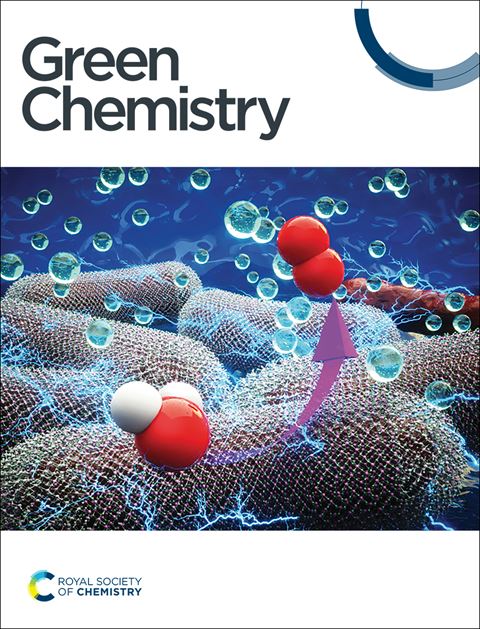Protective fractionation of highly uncondensed lignin with high purity and high yield: new insights into propanediol-blocked lignin condensation†
IF 9.2
1区 化学
Q1 CHEMISTRY, MULTIDISCIPLINARY
引用次数: 0
Abstract
A lignin-first separation strategy can help improve the economic and environmental benefits of biorefinery. However, the self-condensation of lignin remains an insurmountable bottleneck in its isolation and valorization process. Therefore, the challenge of lignin separation is how to achieve a highly uncondensed lignin with high yield and high purity. In this work, we developed a ternary deep eutectic solvent (DES) based on polyhydric alcohols, which can be used to treat moso bamboo at 80–90 °C to obtain highly uncondensed lignin which is light-colored and highly active. The uncondensed lignin exhibits a high β-O-4 retention rate, up to 52.82/100Ar, accounting for 90.24% of the β-O-4 content in the raw material. At the same time, the maximum yield and purity of uncondensed lignin can reach 33.6% and 95.5%, respectively. Furthermore, through DFT theoretical calculations, we have proved that the lignin protection strategy by 1,2-propanediol is achieved by grafting the hydroxyl functional group to the α position of the benzylic carbocation intermediate, thus revealing the intrinsic mechanism by which polyol effectively blocks lignin condensation. The lignin-first fractionation strategy based on ternary deep eutectic solvents with polyhydric alcohols and Lewis acids overcomes the defects of lignin condensation that is inevitable during lignin separation and depolymerization. It obtains highly uncondensed lignin with high yield and high purity, and provides a new idea for biorefinery under the lignin-first separation strategy.

高纯度和高产率高度未凝聚木质素的保护性分馏:丙二醇阻断木质素凝聚的新见解
木质素优先分离策略有助于提高生物炼制的经济效益和环境效益。然而,木质素的自缩聚是其分离和增值过程中不可克服的瓶颈。因此,木质素分离面临的挑战是如何获得高产率和高纯度的高度未凝聚的木质素。在本研究中,我们开发了一种基于多羟基醇的三元深共晶溶剂(DES),该溶剂可用于在80-90°C下处理毛竹,以获得高度不凝聚的浅色高活性木质素。未凝聚木质素具有较高的β-O-4保留率,可达52.82/100Ar,占原料中β-O-4含量的90.24%。同时,未凝聚木质素的最高得率和纯度分别可达33.6%和95.5%。此外,通过DFT理论计算,我们证明了1,2-丙二醇的木质素保护策略是通过将羟基官能团接枝到苯基碳正离子中间体的α位置来实现的,从而揭示了多元醇有效阻止木质素缩聚的内在机制。基于多羟基醇和路易斯酸三元深共晶溶剂的木质素优先分馏策略克服了木质素分离解聚过程中不可避免的木质素缩聚缺陷。获得了高收率、高纯度、高度不凝聚的木质素,为木质素优先分离策略下的生物炼制提供了新的思路。
本文章由计算机程序翻译,如有差异,请以英文原文为准。
求助全文
约1分钟内获得全文
求助全文
来源期刊

Green Chemistry
化学-化学综合
CiteScore
16.10
自引率
7.10%
发文量
677
审稿时长
1.4 months
期刊介绍:
Green Chemistry is a journal that provides a unique forum for the publication of innovative research on the development of alternative green and sustainable technologies. The scope of Green Chemistry is based on the definition proposed by Anastas and Warner (Green Chemistry: Theory and Practice, P T Anastas and J C Warner, Oxford University Press, Oxford, 1998), which defines green chemistry as the utilisation of a set of principles that reduces or eliminates the use or generation of hazardous substances in the design, manufacture and application of chemical products. Green Chemistry aims to reduce the environmental impact of the chemical enterprise by developing a technology base that is inherently non-toxic to living things and the environment. The journal welcomes submissions on all aspects of research relating to this endeavor and publishes original and significant cutting-edge research that is likely to be of wide general appeal. For a work to be published, it must present a significant advance in green chemistry, including a comparison with existing methods and a demonstration of advantages over those methods.
 求助内容:
求助内容: 应助结果提醒方式:
应助结果提醒方式:


